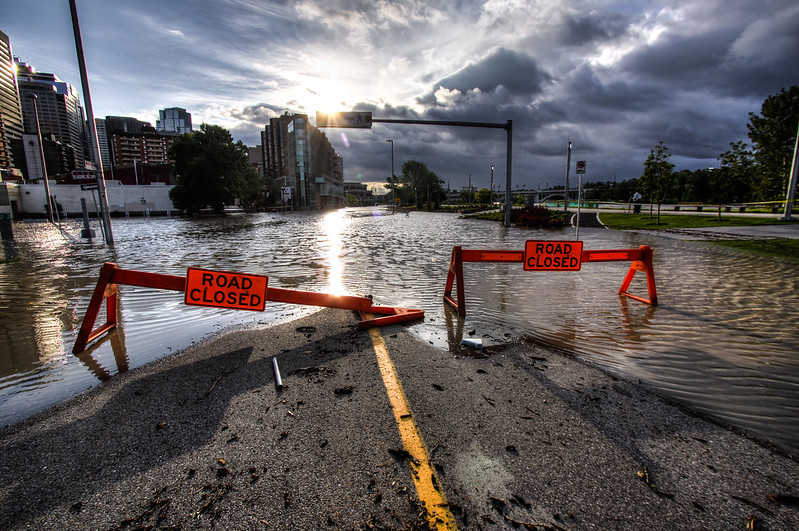Reflecting on the ten year anniversary of the Alberta floods
Image: Riverfront Avenue in Calgary after the 2013 flood. Photo by Ryan Quan.
This June marks the ten year anniversary of the Alberta floods, which included major flooding in Calgary, High River and the surrounding communities. More than 100,000 people were impacted with many losing their homes and some losing their lives.
The staff and volunteers at the time worked quickly to ensure our 24 hour crisis and 211 services were still available, even when we had to evacuate our office for 24 hours. Distress Centre also supported several evacuation centres in Calgary for about six weeks.
First days
At a time when most offices downtown had already closed and sent their staff home, Distress Centre was still operating.
“People were saying ‘well the Mayor is saying to stay home.’ But the calls were still coming in.” Robyn Romano, CEO at Distress Centre, remembers of the time. She was Volunteer Team Lead at Distress Centre in 2013. “So for whoever could make it in, it was all hands on deck.”
In 2013, we didn’t have the remote capabilities that we have today, following the COVID-19 pandemic. Distress Centre was fortunate in that our office at that time, on 8th Avenue SW, was not at risk of flooding. But there were concerns about the electrical grid and the safety and ability of staff and volunteers traveling to the office, as access to downtown was being limited.
“People were saying ‘well the Mayor is saying to stay home.’ But the calls were still coming in. So for whoever could make it in, it was all hands on deck.”
Joan Roy had just recently stepped into the role of Executive Director and one of her first decisions was whether to shut down the agency. Ultimately it was decided to close the office for the safety of our staff and volunteers.
“There were a few of us left at the office and I remember it was an eerie feeling to shut off the lights and walk out of our contact centre, because we had never done that,” Robyn recalls. Our contact centre had been open 24/7 since we first introduced our 24 hour crisis line in the ‘70s. “It was a weird feeling coupled with that unknown of what was going to happen and what the impact would be on the community.”
Our crisis lines were forwarded to Canadian Mental Health Association – Edmonton and our 211 lines were forwarded to 211 British Columbia, to ensure that Calgarians still had access to these services at a critical time.
SORCe (Safe Communities Opportunity and Resource Centre) – of which Distress Centre is one of the agencies – was forced to close its doors just days after opening on June 18th, 2013, as the building was flooded.
First months
Distress Centre was able to return to the office and begin answering crisis and 211 calls again within days of closing and transferring the lines. During this time, calls to 211 increased by 40% and 211 service was extended to High River to help those impacted by the flood.
In addition to that, Distress Centre provided support to the reception centres for the next six weeks.
“It was a long, busy time,” recalls David Kirby, Clinical Services Manager at DC, who was in the same role in 2013. “We developed a schedule around supporting the City’s employees, by providing psychological first aid. We were there to meet and greet people, direct them, do some basic crisis intervention and connect them with resources.”
It was a time of community collaboration. With agencies and organizations quickly coming together to serve the community, at a time when many of those serving were being impacted as well. Both Robyn and David were evacuated from their homes.
In the months and even years that followed, the mental and physical impacts of the flood were topics that came up on our crisis and 211 lines and in counselling sessions.
Learnings and impact
Distress Centre’s response to the flood came with many learnings and ultimately put us in a better position to respond to later disasters and world events, like the 2016 Alberta wildfires and the COVID-19 pandemic.
“We learned how to pivot quickly with each of these different disasters,” David says. “I think our experience with the floods and wildfires gave us the confidence to pivot more easily into pandemic response because we had this track record of success.”
Robyn adds: “It’s not a matter of if the next disaster happens. It’s a matter of when. With each disaster – including the fires impacting the community today – we’re learning and growing and seeing ways to improve not only our internal business practices for our own service delivery, but also growing our collaborative capabilities to better work together with other agencies and organizations to provide the best response to the community.”
Robyn says that one of the things that most stands out to her even ten years later, is how the community came together in 2013.
“One of the things I love about our community here in Calgary is how people come together,” Robyn said. With the floods and wildfires we received many calls to 211 from people asking how they could donate or help.
“The community just wanted to support one another. Everyone was willing to jump in and help. So how do we, in our everyday world, how do we build that same level of community collaboration that comes out during a disaster?”

